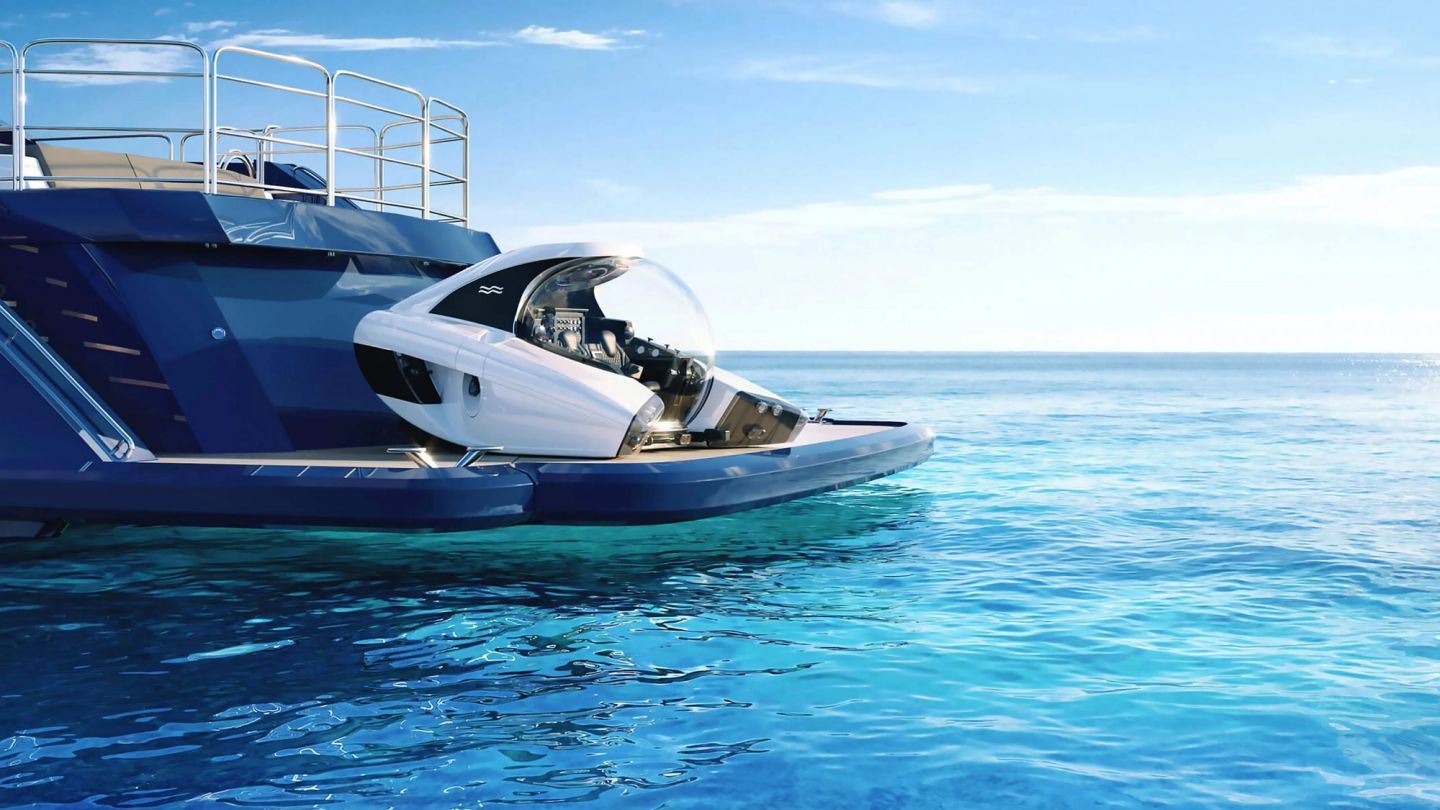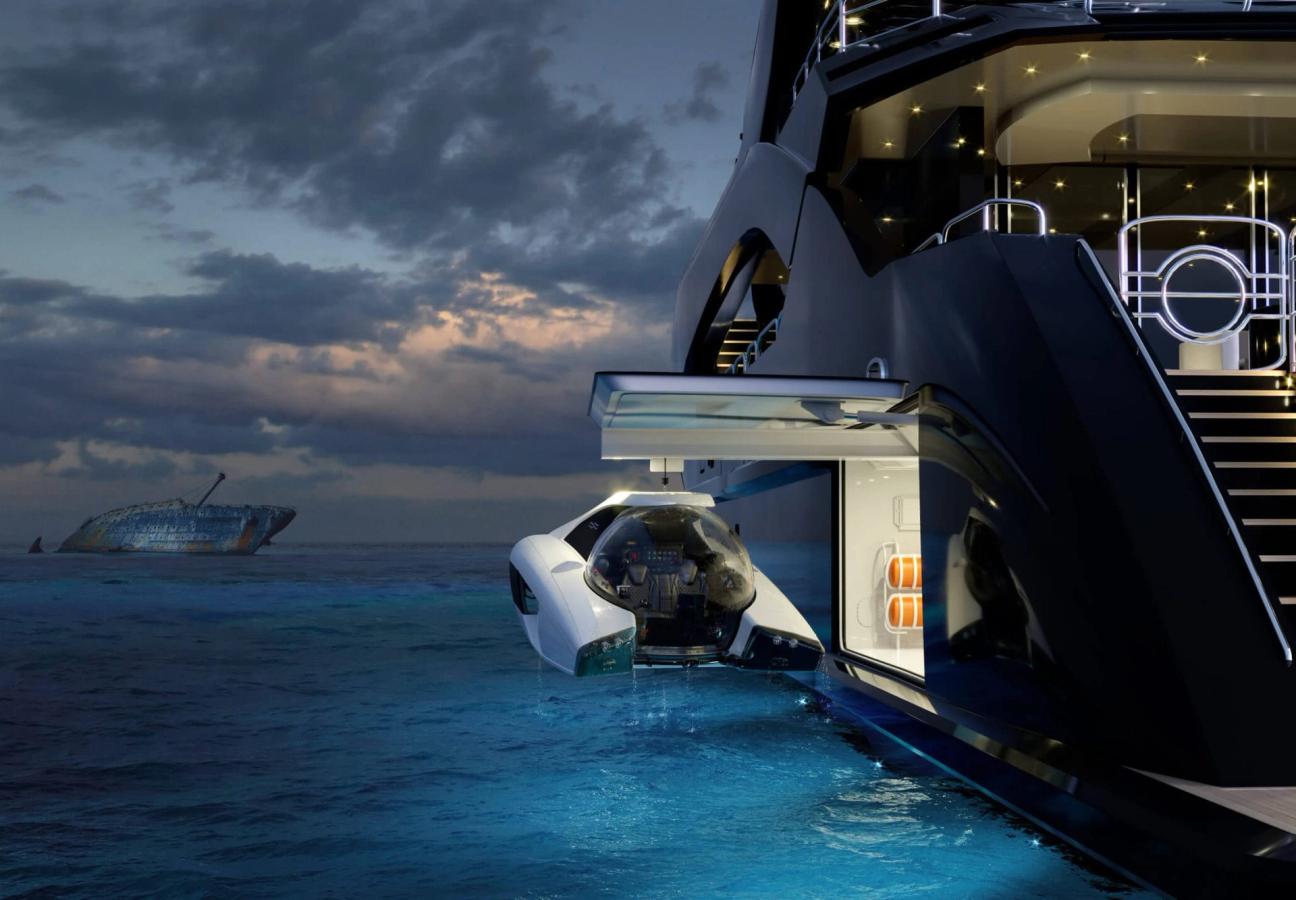

Diving into the expensive, exploratory world of personal submarines
As more personal submersible brands surface, we take a deep dive into the ground-breaking, money-making industry…
Words: Jonathan Wells
There is little left to explore within the world of luxury. From hydrogen supercars to atomic wristwatches, brands have muscled their R&D departments into almost every opulent corner and crevice there is. The same can be said of the world in general — with centuries of adventuring pioneers discovering and documenting almost every inch of the earth.
But both of these worlds share a final, unfinished frontier. Bobbing just below the waves and diving deep into the ocean, personal submersibles can be found swimming at the intersection of exploration and luxury invention. Like the Silicon Valley spacecraft currently readying themselves for the stars, personal submarines are relatively new creations — and were born from the deep pockets and open minds of a select few.
Their sub-aquatic story begins in the early 2000s when, after a successful career in software development, Dutch entrepreneur Bert Houtman listed his company on the stock exchange. As the bell rang, Houtman’s bank balance increased — his office time decreased — and he began searching for a new, luxurious (and preferably nautical) hobby.

“But Houtman,” explains Roy Heijdra, “found that submersibles were the sole domain of military or institutional scientific users. So, in 2005, he founded U-Boat Worx — and began his quest to personalise submarines for everyday use”.
Heijdra, the Marketing Manager of U-Boat Worx, is well-versed in the brand’s ocean-going origin story. Houtman partnered with experts including a Canadian inventor and a Malaysian boatbuilder to successfully launch his first submarine. And, today, the brand operates with a steer towards luxury; adding bespoke touches to almost every one of its craft.
“There’s hardly a sub that leaves the factory floor without a signature design request by the client,” says Heijdra. “And all of our models are built to a bespoke level of luxurious interior — with handcrafted leather seats, Bluetooth audio systems, dual climate controls and mood lighting systems. These luxury options differentiate a private sub from a research sub. Because a researcher doesn’t need a champagne cooler built into his leather seat…”
They certainly wouldn’t. But billionaires love their bubbly — and these big-money men make up most submarine sales. With a handful of brands springing up since U-Boat Worx first took the plunge, individuals including Roman Abramovich, Paul Allen and even Vladimir Putin have all been seen at the controls of their own personal submersibles. The average cost of these high-end models tends to be somewhere between £1 million and £4 million — with most stored aboard their owners’ superyachts.
“We’ve done a lot of beautiful submarine integrations,” says Heijdra, explaining the logistics of delivering these underwater runabouts. “But the one I always found the most interesting was a yacht, which had a large aft swimming pool that could double as a sub pen. The aft door could simply be lowered, and the sub could be submerged from the swimming pool. In my opinion, it doesn’t get more James Bond than that…”
We’d have to agree — unless the sub itself was a 1976 Lotus Esprit, of course. (Coincidentally, Elon Musk has more than his SpaceX Starship in the garage. In 2013, he bought James Bond’s submersible Lotus Esprit ‘Wet Nellie’ from The Spy Who Loved Me — and is currently in the process of converting it into a functioning submarine himself).
"A researcher doesn’t need a champagne cooler built into his leather seat…”
The submarines created by U-Boat Worx — while not as simple to drive as supercars — are not as difficult to pilot as you may think. Despite their deep-diving capabilities and stringent safety measures, Houtman’s brand has always designed and developed its personal submarines to be easily manned and controlled.
“And training is included with the purchase of each submersible,” adds Heidra. “We design our submarines in such a way that they are the most safe, fun and easy to use. We even added a feature for assisted piloting, so the guests can pilot the sub themselves while being supervised by the pilot. And we have our own pilot training facility, on the beautiful [Dutch Caribbean] island of Curaçao”.
This focus, on uncomplicated controls, is what steers the majority of personal submarine manufacturers. Triton Submarines, a Florida-based brand and the other major player in the private submersible sector, prides itself on the intuitive controls of its crafts.

“With just a few minutes of instruction, most people can enjoy driving a Triton,” says Patrick Lahey, President of Triton Submarines. “Unlike more complicated items on a yacht — such as a helicopter — there is really nothing about a Triton that a typical crew member would find intimidating. The yacht itself is far more complex.”
And Triton knows yachts — as well as many other boats, vessels and even commercial submersibles. In fact, many of the key people at the American brand had used or developed submarines industrially before joining Triton; cutting their teeth in the fields of offshore oil drilling, salvage and marine science.
“This experience is infused into every craft we deliver,” adds Lahey. “Because a Triton submersible is analogous to a Swiss army knife — it can be configured to do whatever a client is interested in achieving. We can equip a submersible to do marine science, archaeology, salvage or leave these features out if the intention is to simply enjoy recreational diving.”
Triton submarines, as well as those created by U-Boat Worx and a handful of other boutique brands, have explored almost every ocean around the world. From the Galapagos to the Great Barrier Reef, the Arctic to the Azores, these portable, customisable craft are at the forefront of extreme luxury exploration.
So it makes sense that other luxury brands have taken notice. In 2017, when Triton was showing its brand new 1650/3 LP model at the Monaco Yacht Show, the submarine’s sculpted form and smaller size attracted a delegation from Aston Martin — who revealed that they were interested in collaborating.
“They were drawn to it because of the almost ‘car like’ dimensions,” explains Lahey. At just under two metres in height and four metres in length, it has the look and feel of an underwater car. Naturally, Triton was thrilled to have an opportunity to collaborate with such a venerable and highly regarded brand as Aston Martin.
“I grew up being in love with their cars,” he adds, “and, interestingly, we found Aston Martin shared the company philosophy of Triton, where the emphasis is on quality, not production numbers.”
“A Triton submersible is analogous to a Swiss army knife…”
The resulting craft, ‘Project Neptune’ is a sight to behold. Like the stuff of slick science fiction, the strictly limited-edition submarine runs on an Aston-tuned propulsion system, features the same design language as the British carmaker’s Valkyrie hypercar and has an interior constructed using hand-stitched leather and exquisitely engraved fascia panels.
What’s more, it can be further personalised through Aston Martin’s Warwickshire-based bespoke division, ‘Q’ — where buyers can select different trims, configurations and paint colours, including ‘Sea Storm’ and ‘Quantum Silver’. The options are straight out of a Bond film — and this isn’t the first time a high-end submarine has borrowed its styling cues from cinema.

“The look and feel of the Hydrosphere was inspired by 2001: A Space Odyssey,” says Steve Gresham, Director of Gresham Yacht Design. “Set in space, you see a white spaceship which is long and round — with the control station at one end within a round structure. That was the starting point for the visual language, and we developed it from there.”
Inspired by the team’s work on the OceanXplorer, an 87-metre vessel used by BBC and National Geographic documentary filmmaking teams, Gresham says that the Hydrosphere was devised as a way to streamline and speed up the submarine launch experience. Yet, despite its speedy deployment, he deems the auxiliary module ‘different’ to a submarine, rather than ‘better’.
“What we do know, all too well from our clients, is that getting into the ocean in a submersible takes an hour or two, by which time the reason to go and explore has passed you by. The Hydrosphere is the solution to this problem and prevents important moments from being missed. And, unless you happen to be under the water when the Hydrosphere is deployed, you wouldn’t know it was there.”
The London-based studio has received serious interest in the Hydrosphere, Gresham adds, with existing clients’ responses being particularly positive.
“We can’t say anymore at this stage, but it has certainly captured the imagination of those who have seen it. The technology and know-how to turn this idea into a reality already exist, so it wouldn’t be difficult to build. And, although it could be retrofitted to an existing vessel during a refit, the preferred route would be to integrate it into a new build.”
It’s yet another submersible option in an ever-expanding industry. Since 2005, when Bert Houtman established U-Boat Worx, many start-ups have followed in the brand’s underwater wake. Californian SEAmagine create similar orb-enclosed submarines for between two and nine passengers, with depth-capability ranging from 100 metres to 2,500 metres.
DeepFlight’s submersibles look like fighter jets without wings, can travel up to four knots and are partnered exclusively with the Four Seasons Maldives to give non-superyacht owners a chance to dip their toes in personal submersible waters. And JFD Ortega has created a semi-enclosed submarine — an amphibious bobsleigh for which the semi-exposed pilot must be strapped into scuba gear.
And then there’s Migaloo’s M5 private submarine — which cuts out the super yacht middle-man altogether and submerges the full 150 metre vessel. Across the seas, there are few avenues of this aquatic industry left unexplored — and Triton’s Patrick Lahey is keen to keep at the forefront of the trend.
“We live in a very exciting time,” acknowledges Lahey. “Advancements in materials technology, electronics and analytical software have made it possible for innovative companies like Triton to create incredible products with capabilities difficult to imagine even just five or ten years ago.
“I began my underwater journey more than 40 years ago and the difference in capabilities between the submersibles I piloted in the early part of my career and those we routinely produce today at Triton are vast.”
But, despite the allure of champagne coolers and personalised paint jobs, the engineering still comes first. These additional, bespoke touches may get the billionaires digging (or should that be diving?) a little deeper into their pockets, but most of the money shelled out is to guarantee the dependability and capabilities of the craft.
“Because a submersible is a rugged and resilient machine,” says Lahey. “One capable of withstanding conditions in even the harshest environments on Earth. So we realise that people are not just buying a submersible from us; they’re buying the experiences you can enjoy with one. And they should only be limited by their own imaginations…”
Want more extreme exploratory vehicles? These are the best off-road hypercars…
Become a Gentleman’s Journal member. Find out more here.


